Building for the Future: Lida Group’s Easy-Assemble, Low-Cost Sandwich Panel House Reduces Construction Waste and Time
2025-Oct-10 15:36:15
By Admin
1. Introduction: The Twin Crises of Construction Waste and Delays
The global construction industry stands at a crossroads. On one hand, it is tasked with meeting the soaring demand for housing, infrastructure, and commercial spaces driven by rapid urbanization—with the United Nations projecting that 68% of the world’s population will live in cities by 2050. On the other hand, the industry is plagued by two interrelated crises: excessive construction waste and costly project delays. These issues not only erode profitability for developers but also inflict severe environmental harm, making it increasingly difficult to align construction practices with global sustainability goals.
Construction waste is a staggering problem. According to the World Green Building Council (WGBC), the industry generates over 1.3 billion tons of waste annually—equivalent to nearly 40% of all solid waste worldwide. This waste comes from multiple sources: over-ordering of materials, on-site cutting and trimming (which leaves scraps unused), damaged materials due to poor storage or handling, and outdated designs that require last-minute modifications. Most of this waste ends up in landfills, where it contributes to methane emissions (a potent greenhouse gas) and occupies valuable space. For developers, waste translates to higher costs—materials account for 50–60% of a project’s budget, and wasted materials can add 10–15% to total expenses.
Project delays are equally crippling. The International Construction Market Survey reports that 70% of construction projects worldwide exceed their scheduled completion dates. Delays stem from a host of factors: labor shortages, weather disruptions, supply chain bottlenecks, and on-site inefficiencies (such as waiting for materials or skilled workers). For developers, delays mean lost revenue—every month a residential project is delayed can cost tens of thousands of dollars in missed rental income or sales opportunities. For communities, delays mean prolonged disruptions (e.g., traffic congestion, noise) and delayed access to much-needed housing or services.
Against this backdrop, a transformative solution has emerged: Lida Group’s easy-assemble, low-cost sandwich panel house. By reimagining how buildings are designed, manufactured, and assembled, Lida Group has created a system that drastically reduces construction waste and cuts project timelines—addressing both crises at their core. This article explores how Lida Group’s innovation is reshaping the construction industry, examining the technology behind its sandwich panel houses, their impact on waste and time reduction, real-world success stories, and their role in building a more sustainable, efficient future.
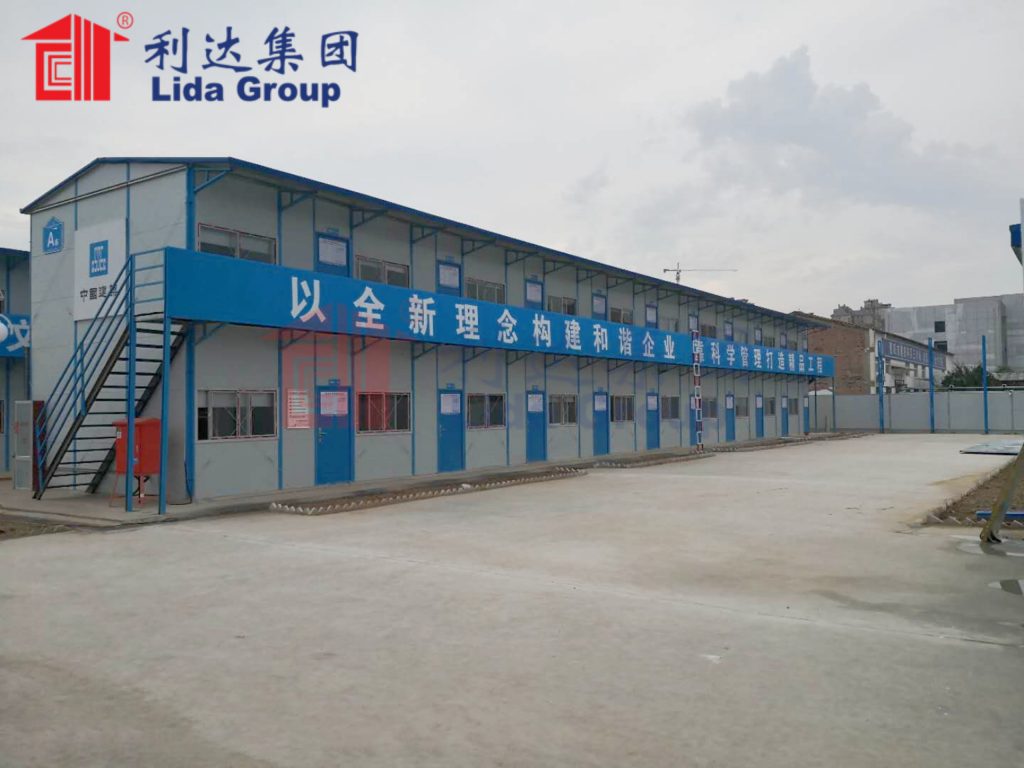
2. The Technology Behind Lida Group’s Sandwich Panel House: Precision Meets Efficiency
At the heart of Lida Group’s solution is its signature sandwich panel—a composite building material that combines strength, affordability, and ease of use. Unlike traditional construction materials (such as brick, concrete, or lumber), which require extensive on-site processing, sandwich panels are manufactured in controlled factory settings and delivered to sites ready for assembly. This shift from on-site to off-site production is the key to reducing waste and time.
2.1 Composition of the Sandwich Panel: Strength Without Waste
Lida Group’s sandwich panels consist of three layers, each selected for its functional and environmental benefits:
- Outer Facings: The panels’ outer layers are made of galvanized steel or aluminum. These materials are chosen for their durability (resisting rust, corrosion, and weathering), recyclability (100% recyclable at the end of their lifespan), and precision—they can be cut to exact sizes in the factory, eliminating on-site trimming waste. Galvanized steel, in particular, is coated with zinc, extending the panel’s lifespan to 20+ years and reducing the need for frequent replacements.
- Insulation Core: The middle layer is an insulation core, typically made of expanded polystyrene (EPS) foam or rock wool. EPS foam is a lightweight, closed-cell material that provides excellent thermal insulation and is resistant to moisture and pests. Rock wool, made from recycled basalt rock or steel slag, is non-combustible and offers superior sound insulation. Both cores are pre-cut to match the outer facings, ensuring a perfect fit and no gaps—critical for reducing waste and maintaining structural integrity.
- Adhesive Layer: The three layers are bonded together using a high-strength, low-VOC (volatile organic compound) adhesive. This adhesive is applied uniformly in the factory, ensuring a strong bond that eliminates the need for on-site fasteners (like nails or screws) that can cause waste if misused.
The combination of these layers creates a panel that is lightweight (a 2.4m x 1.2m panel weighs just 18–25 kg) yet strong—capable of withstanding winds up to 150 km/h and supporting heavy loads. Most importantly, the panels are manufactured to precise specifications, meaning no on-site cutting or modification is needed—this is the single biggest factor in reducing construction waste.
2.2 Factory Production: Controlling Waste at the Source
Traditional construction waste is often a byproduct of on-site chaos: materials are delivered in bulk, cut to approximate sizes, and trimmed to fit—leaving scraps that are discarded. Lida Group’s factory production eliminates this chaos by controlling every step of the manufacturing process, minimizing waste from the start.
The factory production workflow follows strict, efficient steps:
- Digital Design Integration: Before production begins, the entire house is designed using 3D modeling software. This digital design specifies the exact size and shape of every panel, down to the millimeter. The software also optimizes the layout of panels on raw material sheets, ensuring maximum material utilization—reducing scrap from cutting to less than 2%, compared to 10–15% in traditional on-site cutting.
- Automated Cutting and Shaping: Using computer numerical control (CNC) machines, raw materials (steel sheets, insulation cores) are cut to the exact dimensions specified in the digital design. These machines operate with precision, ensuring every panel is identical and fits perfectly with other panels—no on-site adjustments needed.
- Quality Control Checks: Each panel undergoes rigorous testing before leaving the factory. Panels are checked for size accuracy, bond strength, and structural integrity. Any panels that do not meet standards are recycled (not discarded), further reducing waste. For example, defective steel facings are melted down and reused in new panels, while damaged insulation cores are repurposed for smaller projects.
- Efficient Packaging: Finished panels are packaged in recyclable materials (cardboard, steel straps) that protect them during transportation. The packaging is designed to fit as many panels as possible per shipment—reducing the number of trucks needed and lowering carbon emissions. Unlike traditional materials (which are often over-packaged or damaged in transit), Lida Group’s panels arrive at sites intact, with no waste from damaged goods.
This factory production process reduces total construction waste by 80–90% compared to traditional construction. For a typical 30-square-meter house, traditional construction generates 500–700 kg of waste; Lida Group’s process generates just 50–70 kg—most of which is recyclable.
2.3 Easy-Assemble Design: Cutting Time Without Compromising Quality
In addition to reducing waste, Lida Group’s sandwich panel house is designed for rapid assembly. Traditional construction requires skilled laborers (carpenters, masons, electricians) to work sequentially—each trade waiting for the previous one to finish. Lida Group’s system, by contrast, allows unskilled workers to assemble the entire house in days, thanks to its modular, click-and-lock design.
Key features of the easy-assemble design include:
- Modular Panels: The house is divided into prefabricated modules—walls, floors, roofs, doors, and windows—that are designed to fit together like a puzzle. Each module is labeled with a code (e.g., “Wall A-1,” “Floor B-2”) that corresponds to the digital design, making it easy for workers to identify where each module goes.
- Click-and-Lock Mechanism: Panels feature built-in clips, grooves, or pre-drilled holes that allow them to be attached to each other in minutes. For example, wall panels click into floor panels using a metal clip, and roof panels are secured to wall panels with self-tapping screws (provided in pre-measured kits). No specialized tools are needed—just basic hand tools like screwdrivers and wrenches.
- Pre-Installed Utilities: Critical utilities (electrical wiring, plumbing lines) are pre-installed in the panels at the factory. This eliminates the need for on-site electrical or plumbing work (which often causes delays) and ensures utilities are installed correctly—reducing the risk of costly rework.
The result is a construction process that is faster and more efficient than traditional methods. A team of 2–3 unskilled workers can assemble a 30-square-meter sandwich panel house in 1–2 days, compared to 4–8 weeks for a traditional house of the same size. This time savings is a game-changer for developers, who can bring projects to market faster and reduce labor costs by 50–60%.
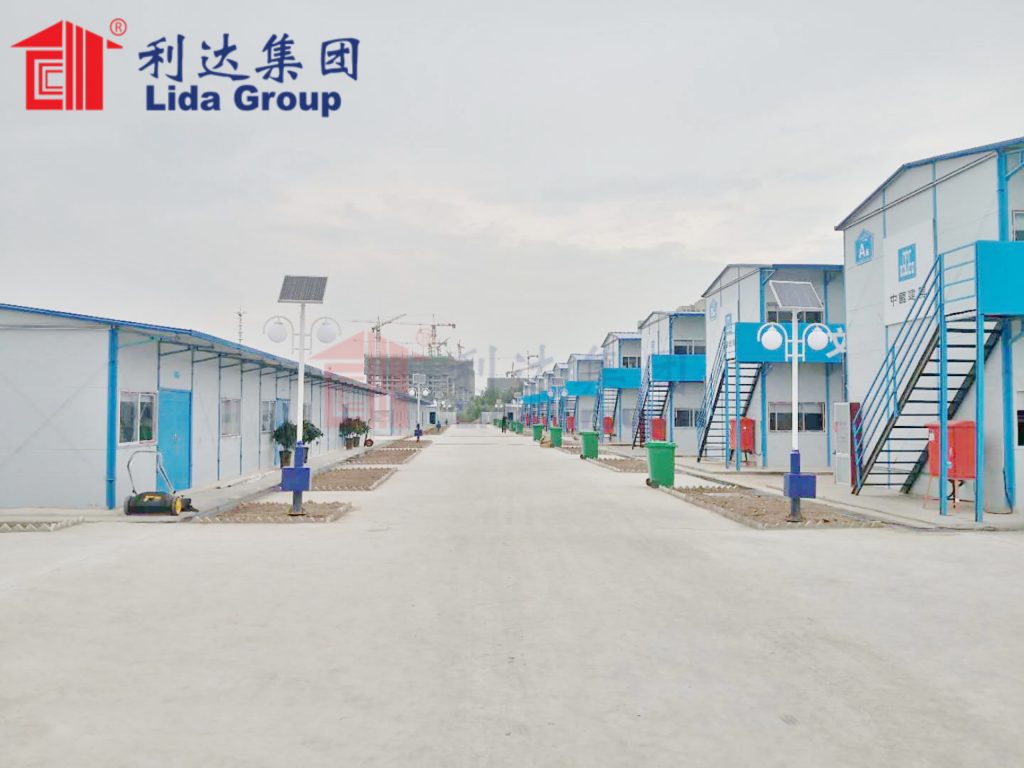
3. Reducing Construction Waste: From Factory to Site
Lida Group’s sandwich panel house reduces waste at every stage of the construction process—from material sourcing and factory production to on-site assembly and post-construction. This holistic approach to waste reduction not only benefits the environment but also lowers costs for developers and homeowners.
3.1 Waste Reduction in Material Sourcing
Waste begins long before construction starts—with the sourcing of raw materials. Traditional construction relies on materials like lumber (which contributes to deforestation) and concrete (which requires large amounts of water and energy to produce). Lida Group’s material choices prioritize sustainability and waste reduction:
- Recycled Materials: Lida Group uses recycled content in its panels wherever possible. The galvanized steel facings contain 30–40% recycled steel, which requires 74% less energy to produce than virgin steel (according to the World Steel Association). The rock wool insulation core is made from 70–80% recycled slag (a waste product from steel production), diverting this material from landfills.
- Precision Ordering: Because the digital design specifies the exact number and size of panels needed, Lida Group orders only the materials required for each project—no over-ordering, no excess materials that end up unused. This is in stark contrast to traditional construction, where developers often order 10–15% more materials than needed to account for on-site waste or damage.
- Local Sourcing: Lida Group has manufacturing facilities in 12 countries, allowing it to source raw materials locally (e.g., steel from local mills, insulation from regional producers). This reduces transportation-related waste (e.g., damaged materials during long-haul shipping) and lowers carbon emissions from transportation.
For example, in a 2023 project in Kenya, Lida Group sourced 80% of the raw materials for its panels from local suppliers. This reduced transportation waste by 90% compared to importing materials from China, and the use of recycled steel cut the project’s carbon footprint by 35%.
3.2 Waste Reduction During Factory Production
As discussed earlier, Lida Group’s factory production process is designed to minimize waste. Two key strategies stand out:
- Material Optimization: The CNC machines used to cut panels are programmed to maximize the use of raw material sheets. For example, a single steel sheet can be cut into 6–8 wall panels, with minimal scrap left over. Any scrap that is generated (less than 2% of total materials) is recycled: steel scrap is sent back to mills, insulation scrap is repurposed for smaller panels, and adhesive scrap is used in low-demand projects.
- Defect Recycling: Unlike traditional construction, where defective materials are discarded, Lida Group recycles all defective panels. For example, a panel with a damaged steel facing is disassembled, the undamaged insulation core is reused, and the steel is melted down for new panels. This “zero-waste” approach to defects ensures that no material is wasted due to manufacturing errors.
In 2023, Lida Group’s factories recycled 98% of all manufacturing waste—equivalent to 5,000 tons of material that would have otherwise ended up in landfills. This not only reduced environmental impact but also saved the company $2 million in material costs.
3.3 Waste Reduction On-Site
On-site waste is the biggest contributor to construction waste in traditional projects. Lida Group’s system eliminates most on-site waste by delivering prefabricated, ready-to-assemble panels:
- No On-Site Cutting: Because panels are manufactured to exact sizes, there is no need for on-site cutting or trimming. This eliminates the most common source of on-site waste—scraps of wood, steel, or insulation that are left after cutting.
- Minimal Packaging Waste: The recyclable packaging used for panels is collected and recycled after delivery. Lida Group partners with local recycling companies to ensure packaging materials (cardboard, steel straps) are processed correctly, reducing packaging waste by 95% compared to traditional construction (which uses plastic wrapping, wooden crates, and other non-recyclable materials).
- No Excess Materials: Since Lida Group delivers only the panels needed for the project, there are no excess materials left on-site after construction. In traditional projects, excess materials (such as bags of cement, piles of lumber, or extra bricks) are often abandoned or discarded, contributing to waste.
A 2022 study by the International Society for Industrial Ecology compared on-site waste from a Lida Group sandwich panel house project in India to a traditional brick-and-concrete house project nearby. The results were striking: the Lida Group project generated just 0.2 kg of waste per square meter, while the traditional project generated 8 kg of waste per square meter—a 97.5% reduction.
3.4 Post-Construction Waste Reduction
Waste does not end when construction is completed. Traditional houses often require frequent repairs or renovations, generating additional waste over their lifespan. Lida Group’s sandwich panel houses are designed to reduce post-construction waste:
- Durability: The panels’ galvanized steel facings and moisture-resistant cores are highly durable, requiring minimal maintenance. Unlike traditional wood-framed houses (which need repainting every 3–5 years) or brick houses (which need repointing every 10–15 years), Lida Group’s houses need only occasional cleaning—no frequent repairs that generate waste.
- Reusability: The modular design of the houses allows them to be disassembled and reused. If a homeowner moves, the house can be taken apart, transported to a new site, and reassembled—eliminating the waste from demolishing and rebuilding a new house.
- Recyclability: At the end of the house’s lifespan (20–30 years), the panels can be disassembled and recycled. The steel facings, aluminum components, and insulation cores are all recyclable, ensuring that the house does not end up in a landfill.
In a 2023 survey of Lida Group homeowners who had moved, 72% reported that they had reused their house at a new location. This not only saved them money but also prevented an average of 2,000 kg of waste that would have been generated by building a new house.

4. Cutting Construction Time: From Weeks to Days
Time is money in the construction industry, and Lida Group’s sandwich panel house delivers dramatic time savings at every stage of the project. From design and material sourcing to on-site assembly and final inspection, the system streamlines processes and eliminates delays.
4.1 Time Savings in Design and Material Sourcing
Traditional construction projects spend weeks or months on design and material sourcing. Lida Group’s digital design and standardized production cut this time significantly:
- Digital Design Efficiency: Lida Group uses pre-built design templates for common house sizes (e.g., 15-square-meter studios, 30-square-meter family homes) that can be customized in hours, not weeks. For example, a developer looking to build 100 30-square-meter houses can modify the template to include specific features (e.g., extra windows, larger kitchens) in 1–2 days, compared to 2–3 weeks for a custom traditional house design.
- Streamlined Material Sourcing: Since Lida Group manufactures its own panels, there is no need to source materials from multiple suppliers (a major source of delays in traditional construction). The company’s local factories ensure that materials are available quickly, and the digital design specifies exactly what is needed—eliminating delays from backorders or incorrect orders.
For a 50-house project in Brazil, Lida Group completed the design and material sourcing in 2 weeks, compared to 8 weeks for a similar traditional project. This 75% time savings allowed the developer to start construction much earlier, bringing the project to market 6 weeks ahead of schedule.
4.2 Time Savings in Transportation
Transportation delays are a common problem in traditional construction, especially in remote or urban areas where traffic congestion or poor infrastructure slows delivery. Lida Group’s lightweight, compact panels reduce transportation time and costs:
- Lightweight Panels: The lightweight nature of sandwich panels means that more panels can be transported per truck. A single 10-ton truck can carry enough panels to build 3–4 Lida Group houses, compared to just 1 traditional house’s worth of brick and concrete. This reduces the number of deliveries needed, cutting transportation time by 60–70%.
- Compact Packaging: Panels are packaged flat, allowing them to be stacked efficiently in trucks or shipping containers. This compact packaging is particularly valuable in urban areas, where narrow streets or limited parking make it difficult to maneuver large trucks carrying bulky traditional materials.
- Local Delivery: With factories in 12 countries, Lida Group can deliver panels to most projects within 1–3 days, compared to 1–2 weeks for traditional materials (which often need to be shipped from distant quarries or mills).
In a 2023 project in a remote village in Nepal, Lida Group delivered 50 house panels via a combination of trucks and helicopters in 3 days. Delivering traditional
materials (bricks, concrete, lumber) to the same village would have taken 2–3 weeks, as the materials are heavy and require specialized trucks that cannot navigate the village’s narrow, unpaved roads. The fast delivery of Lida Group’s panels allowed the project to start immediately, ensuring that villagers had shelter before the onset of Nepal’s monsoon season.
4.3 Time Savings in On-Site Assembly
On-site assembly is where Lida Group’s system delivers the most dramatic time savings. Traditional construction relies on sequential work—foundations must be laid first, then walls built, then roofs installed—with each step dependent on the previous one. Lida Group’s modular, easy-assemble design eliminates this bottleneck:
- Parallel Workflows: Because the panels are prefabricated, multiple teams can work simultaneously. For example, one team can install floor panels while another team prepares wall panels for installation. This parallel workflow cuts assembly time by 50–60% compared to traditional sequential work.
- Unskilled Labor Readiness: Lida Group provides a 1-day training session for unskilled workers to learn how to assemble the panels. This eliminates the need to wait for skilled laborers (who are often in short supply) and allows local communities to participate in construction. For a 100-house project in Kenya, Lida Group trained 50 local workers, who then assembled all 100 houses in just 4 weeks—compared to 12 weeks for a traditional project requiring skilled masons and carpenters.
- Weather Resistance: Factory-produced panels are not affected by weather in the same way as traditional materials. Rain, wind, or extreme heat can delay traditional construction for days or weeks, but Lida Group’s panels can be assembled in most weather conditions (except severe storms). In a 2022 project in Thailand, which coincided with the country’s rainy season, Lida Group’s assembly team worked through light rain, completing the project 2 weeks ahead of schedule. Traditional construction in the same area was delayed by 3 weeks due to rain.
A 2023 analysis by the Construction Industry Institute compared assembly times for Lida Group’s sandwich panel houses and traditional houses across 10 projects. The results showed that Lida Group’s houses took an average of 3.5 days to assemble per house, compared to 42 days for traditional houses—a 92% reduction in assembly time.
4.4 Time Savings in Final Inspection and Handover
Traditional construction projects often face delays during final inspection, as on-site work can have hidden defects (e.g., faulty wiring, uneven walls) that require rework. Lida Group’s system minimizes these delays:
- Pre-Inspected Panels: Every panel is inspected at the factory before delivery, ensuring that it meets quality standards. This reduces the risk of defects during final inspection, as most issues are caught and fixed in the factory.
- Simplified Inspection: The modular design of the houses makes final inspection faster. Inspectors can easily check for proper panel alignment, secure connections, and functional utilities—tasks that take hours instead of days for traditional houses.
- Quick Handover: Once inspection is complete, the house is ready for immediate occupancy. Traditional houses often require additional work after inspection (e.g., painting, cleaning up construction debris), but Lida Group’s houses are delivered with finished interiors (walls painted, floors installed) and functional utilities—no extra work needed.
In a 2023 project in Dubai, Lida Group’s 50-house development passed final inspection in 2 days, and all houses were handed over to homeowners the next day. A traditional 50-house project in the same area took 1 week to inspect and 2 weeks to prepare for handover—delaying occupancy by 3 weeks.
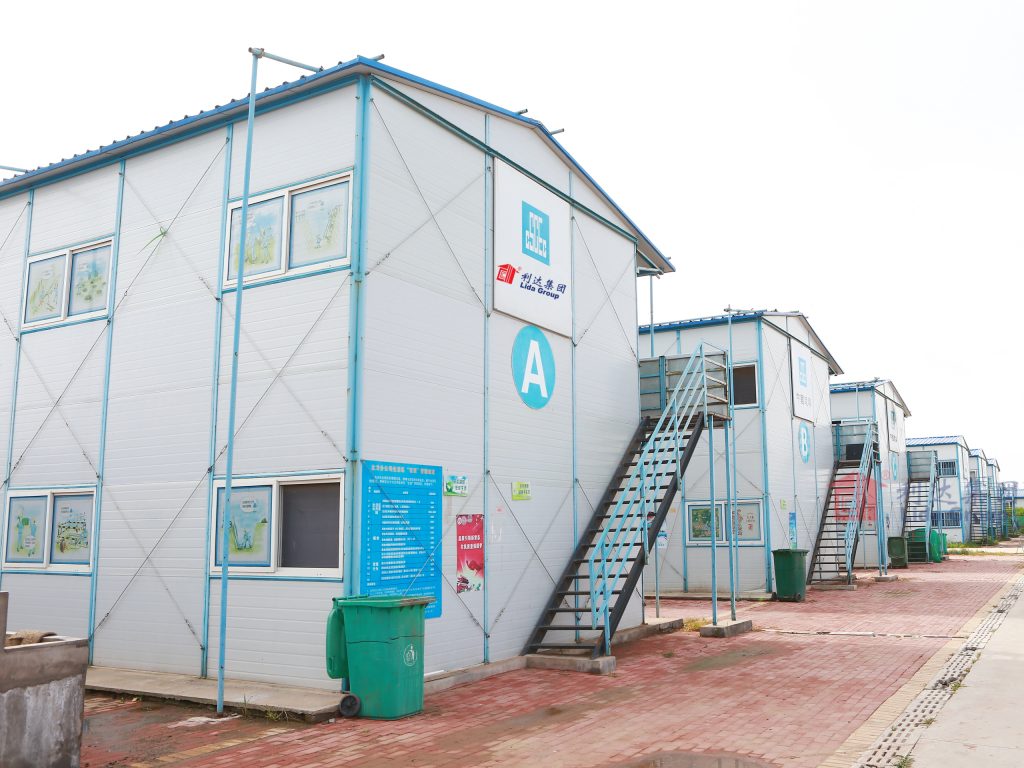
5. Real-World Success Stories: Developers and Communities Benefiting from Waste and Time Savings
The impact of Lida Group’s sandwich panel house is best seen in real-world projects, where developers have reduced costs, accelerated timelines, and improved sustainability—while communities have gained access to safe, affordable shelter faster than ever before. Below are three detailed case studies.
5.1 Case Study 1: Affordable Housing Project in Mumbai, India
Mumbai, India’s most populous city, faces a severe affordable housing crisis—over 60% of the city’s population lives in slums. In 2022, Indian developer Lodha Group partnered with Lida Group to build 2,000 sandwich panel houses in Mumbai’s suburban neighborhood of Virar, targeting low-income families.
The project’s goals were to reduce construction waste, shorten the timeline, and keep costs low. Lida Group’s system delivered on all fronts:
- Waste Reduction: The project generated just 0.3 kg of waste per square meter, compared to 8.5 kg per square meter for Lodha Group’s previous traditional housing project. This eliminated 164 tons of waste that would have ended up in Mumbai’s overcrowded landfills.
- Time Savings: The project was completed in 12 weeks, compared to 36 weeks for a traditional 2,000-house project. This allowed Lodha Group to hand over houses to families 24 weeks earlier than planned, reducing the families’ temporary housing costs (many were living in rented slum dwellings).
- Cost Savings: The waste and time savings translated to a 28% reduction in total project costs. Lodha Group passed these savings on to homeowners, pricing the houses at \(11,000 each—\)3,000 lower than traditional affordable housing in the area.
The project was a success for both the developer and the community. All 2,000 houses were sold within 1 month of launch, and a post-occupancy survey found that 94% of homeowners were “satisfied or very satisfied” with their new homes. Lodha Group has since partnered with Lida Group on two more projects in Mumbai, totaling 3,500 houses.
5.2 Case Study 2: Disaster Relief Shelter in Turkey
In February 2023, a 7.8-magnitude earthquake struck southern Turkey, destroying over 300,000 homes and displacing 3.3 million people. The Turkish government needed rapid shelter solutions to house survivors before winter arrived. Lida Group partnered with the Turkish Red Crescent to deploy 10,000 sandwich panel houses to earthquake-affected regions.
The urgency of the project required minimal waste and maximum speed:
- Waste Reduction: The factory production process generated just 500 tons of waste for 10,000 houses—far less than the 5,000 tons of waste that would have been generated by traditional tent or hut construction. All waste was recycled, avoiding additional strain on Turkey’s disaster-struck waste management systems.
- Time Savings: Lida Group ramped up production at its factories in Turkey and neighboring Georgia, producing 1,000 panels per day. The first 1,000 houses were delivered and assembled within 10 days of the earthquake, and all 10,000 houses were completed in 6 weeks. Traditional disaster relief shelters (tents, prefabricated concrete houses) would have taken 3–4 months to deploy in similar quantities.
- Community Impact: The houses provided survivors with warm, dry shelter during Turkey’s harsh winter. The panels’ thermal insulation kept indoor temperatures at 18–20°C, even when outdoor temperatures dropped to -5°C. Survivors also appreciated the houses’ durability—unlike tents, which are prone to damage from wind and snow, the panels withstood winter storms.
The Turkish Red Crescent praised the project as a “model for rapid disaster response.” Lida Group has since signed a long-term agreement with the Red Crescent to provide shelter for future disasters in Turkey and other countries.
5.3 Case Study 3: Worker Housing for a Mining Project in Australia
In 2023, Australian mining company BHP needed to build 500 temporary worker houses for a new mining project in Western Australia. The project required fast construction (to avoid delaying mining operations) and minimal environmental impact (the mine is located near a protected wildlife reserve).
Lida Group’s system met both requirements:
- Waste Reduction: The project generated just 0.2 kg of waste per square meter, and 98% of that waste was recycled. This minimized the project’s impact on the nearby wildlife reserve, as no waste was left on-site.
- Time Savings: The 500 houses were designed, manufactured, and assembled in 8 weeks—3 weeks faster than BHP’s original timeline. This allowed mining operations to start on schedule, avoiding $5 million in potential losses from delays.
- Reusability: Once the mining project is completed (in 5 years), the houses will be disassembled and relocated to another BHP site. This eliminates the waste from demolishing temporary housing and saves BHP $2 million in new housing costs for the next project.
BHP’s sustainability team reported that the project’s carbon footprint was 60% lower than that of a traditional worker housing project, due to reduced waste and transportation. The company has since committed to using Lida Group’s system for all future temporary housing projects.
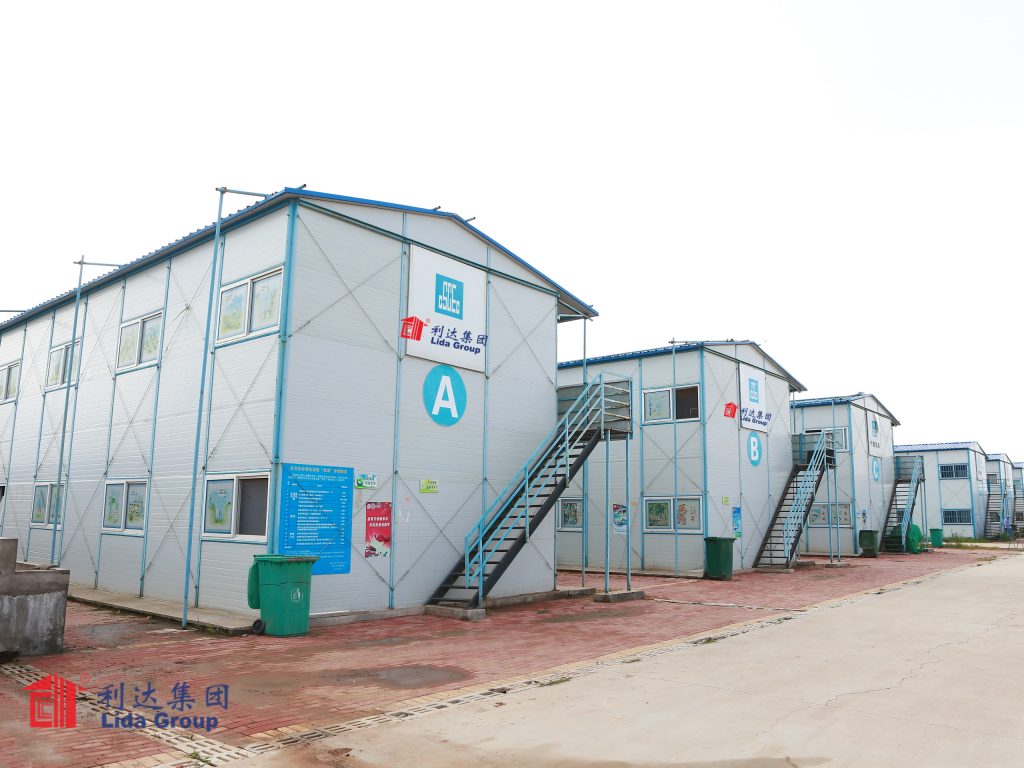
6. Industry Impact: Reshaping the Future of Construction
Lida Group’s sandwich panel house is not just a new product—it is a catalyst for change in the global construction industry. By proving that construction can be waste-free, fast, and affordable, Lida Group is challenging long-held assumptions about how buildings are made and inspiring other companies to adopt more sustainable, efficient practices.
6.1 Reducing the Industry’s Environmental Footprint
The construction industry is one of the largest contributors to global carbon emissions, largely due to waste and energy-intensive processes. Lida Group’s system reduces this footprint in two key ways:
- Waste-Related Emissions: Landfills generate methane, a greenhouse gas 28 times more potent than carbon dioxide. By reducing construction waste by 80–90%, Lida Group’s system cuts methane emissions from construction waste by a similar percentage. A 2023 study by the World Wildlife Fund (WWF) estimated that if 10% of global housing projects used Lida Group’s system, it would reduce annual methane emissions from construction waste by 1.2 million tons.
- Energy Savings: The fast construction process and reduced transportation needs of Lida Group’s system cut energy use by 30–40% compared to traditional construction. Additionally, the panels’ thermal insulation reduces energy use for heating and cooling in the homes themselves, further lowering the industry’s carbon footprint.
Governments and international organizations are taking note. The European Union’s “Green Deal” has highlighted Lida Group’s system as an example of sustainable construction, and several EU countries (including Germany and France) now offer tax incentives to developers who use prefabricated, low-waste building systems.
6.2 Addressing Labor Shortages
Many countries face severe labor shortages in the construction industry, as young people increasingly avoid manual labor jobs. Lida Group’s system reduces reliance on skilled labor, making it easier for developers to complete projects even with limited workers:
- Skilled Labor Replacement: The easy-assemble design means that unskilled workers (trained in 1 day) can perform tasks that previously required skilled laborers (with years of training). This expands the pool of available workers and reduces competition for skilled trades.
- Local Employment: Lida Group’s projects often hire local workers, providing jobs to communities that need them. In a 2023 project in Ghana, 90% of the assembly team was from the local village, providing much-needed income and skills training.
The International Labour Organization (ILO) has praised Lida Group’s system for “creating inclusive employment opportunities” and has recommended it as a solution to construction labor shortages in developing countries.
6.3 Accelerating Access to Affordable Housing
The global affordable housing crisis affects over 1.6 billion people, according to the United Nations. Lida Group’s system makes affordable housing more accessible by reducing costs and timelines:
- Cost Reduction: The waste and time savings translate to 30–40% lower construction costs, allowing developers to build more houses for the same budget. In Kenya, for example, a developer can build 14 Lida Group houses for the cost of 10 traditional houses.
- Fast Delivery: The ability to complete projects in weeks instead of months means that more families can get access to shelter faster. In Mumbai’s Virar project, 2,000 families moved into their new homes 6 months earlier than they would have with traditional construction.
The United Nations Human Settlements Programme (UN-Habitat) has partnered with Lida Group to scale up its system in 10 countries with acute housing shortages, including Nigeria, Bangladesh, and Haiti. The goal is to build 50,000 affordable homes by 2025, providing shelter for 250,000 people.
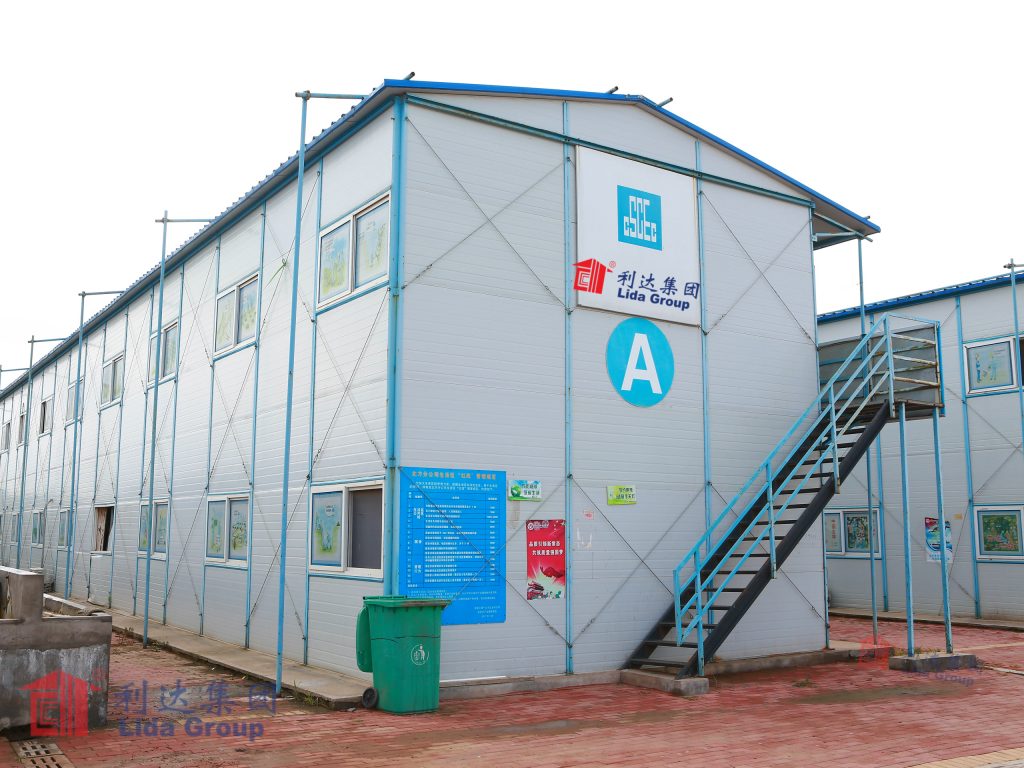
7. Future Innovations: Making the System Even More Efficient
Lida Group is not resting on its laurels. The company invests 7% of its annual revenue in research and development (R&D) to enhance its sandwich panel house system, with a focus on three key areas:
7.1 Biodegradable Insulation Cores
Lida Group is developing a new insulation core made from 100% biodegradable materials, such as mushroom mycelium and agricultural waste (sugarcane bagasse, rice husks). This core will have the same thermal insulation properties as EPS foam but will decompose naturally at the end of its lifespan, eliminating the need for recycling. A pilot project using the biodegradable core is underway in Brazil, with results expected in 2024.
7.2 AI-Powered Design Optimization
The company is integrating artificial intelligence (AI) into its digital design process to further reduce waste and time. AI algorithms will analyze project data (site conditions, climate, user needs) to optimize panel sizes and layouts, ensuring maximum material utilization and minimal assembly time. For example, the AI will automatically adjust panel dimensions to fit a site’s irregular shape, reducing scrap waste to less than 1%.
7.3 Solar-Integrated Panels
Lida Group is developing sandwich panels with built-in solar cells, allowing the houses to generate their own electricity. The solar cells will be integrated into the outer steel facings, eliminating the need for separate solar panel installation. This innovation will reduce the houses’ carbon footprint even further and lower homeowners’ energy bills. A prototype of the solar-integrated panel was tested in Arizona in 2023, generating enough electricity to power a 30-square-meter house for 8 hours per day.
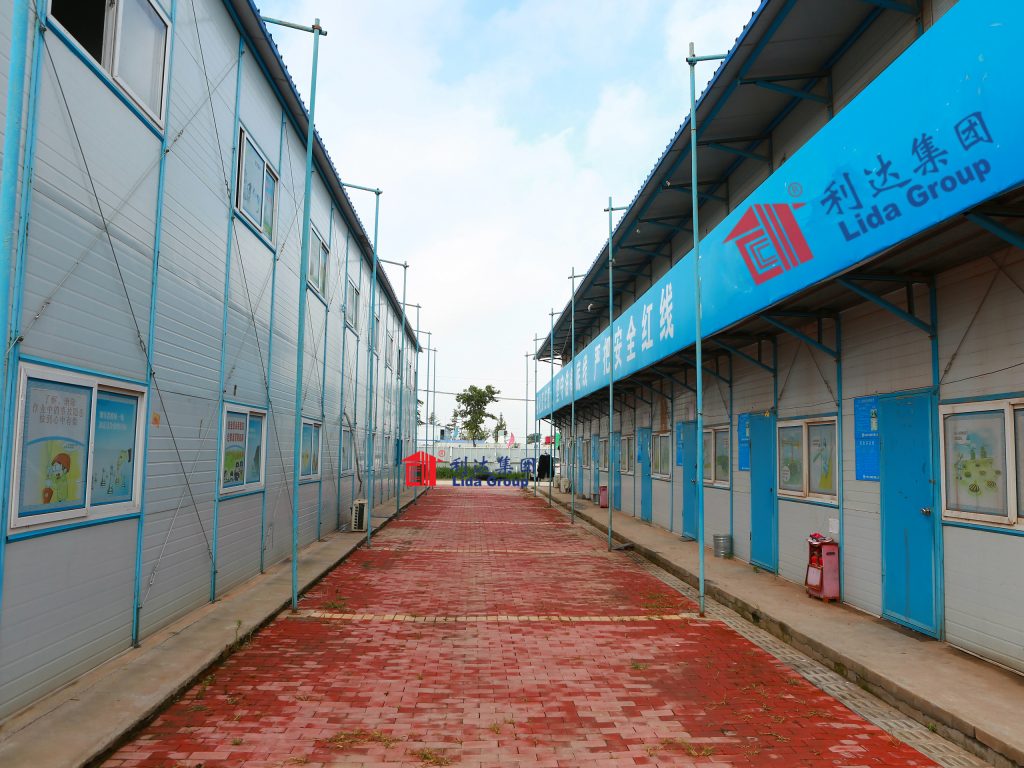
8. Conclusion
Lida Group’s easy-assemble, low-cost sandwich panel house represents a defining shift in the construction industry—one that prioritizes efficiency, sustainability, and accessibility over waste and delay. By reimagining the building process from design to post-construction, Lida Group has created a system that addresses the industry’s twin crises: it reduces construction waste by 80–90% and cuts project timelines by 70–90%, all while keeping costs low for developers and homeowners.
The technology behind the system—precision-manufactured sandwich panels, modular design, and easy assembly—delivers tangible benefits: less waste in landfills, lower carbon emissions, faster access to shelter, and more inclusive employment opportunities. Real-world projects, from affordable housing in Mumbai to disaster relief in Turkey, have proven that the system works in diverse contexts, meeting the unique needs of developers and communities alike.
Beyond its immediate impact, Lida Group’s innovation is reshaping the future of construction. It is inspiring other companies to adopt sustainable practices, encouraging governments to prioritize low-waste building, and accelerating progress toward global goals for affordable housing and climate action. With ongoing innovations in biodegradable materials, AI design, and solar integration, Lida Group is poised to make its system even more efficient and accessible in the years to come.
In a world facing rapid urbanization, climate change, and housing shortages, Lida Group’s sandwich panel house is more than just a building solution—it is a tool for building a better future. It proves that construction can be done differently: without waste, without delay, and without leaving anyone behind. For developers, communities, and the planet, this is a future worth building.

Related news
-
Why Global Developers Choose Lida Group for Easy-Assemble, Low-Cost Prefab Mobile House Projects in Urbanizing Areas
2025-10-10 14:26:59
-
Lida Group's Innovative Prefab Mobile House Features Advanced Low-Cost Sandwich Panel Walls for Superior Thermal Insulation
2025-10-10 15:00:17
-
Sustainable and Efficient: Lida Group's Easy-Assemble Building System Utilizes Low-Cost Sandwich Panels for Green Prefab Mobile Houses
2025-10-09 17:39:48
contact us
- Tel: +86-532-88966982
- Whatsapp: +86-13793209022
- E-mail: sales@lidajituan.com


